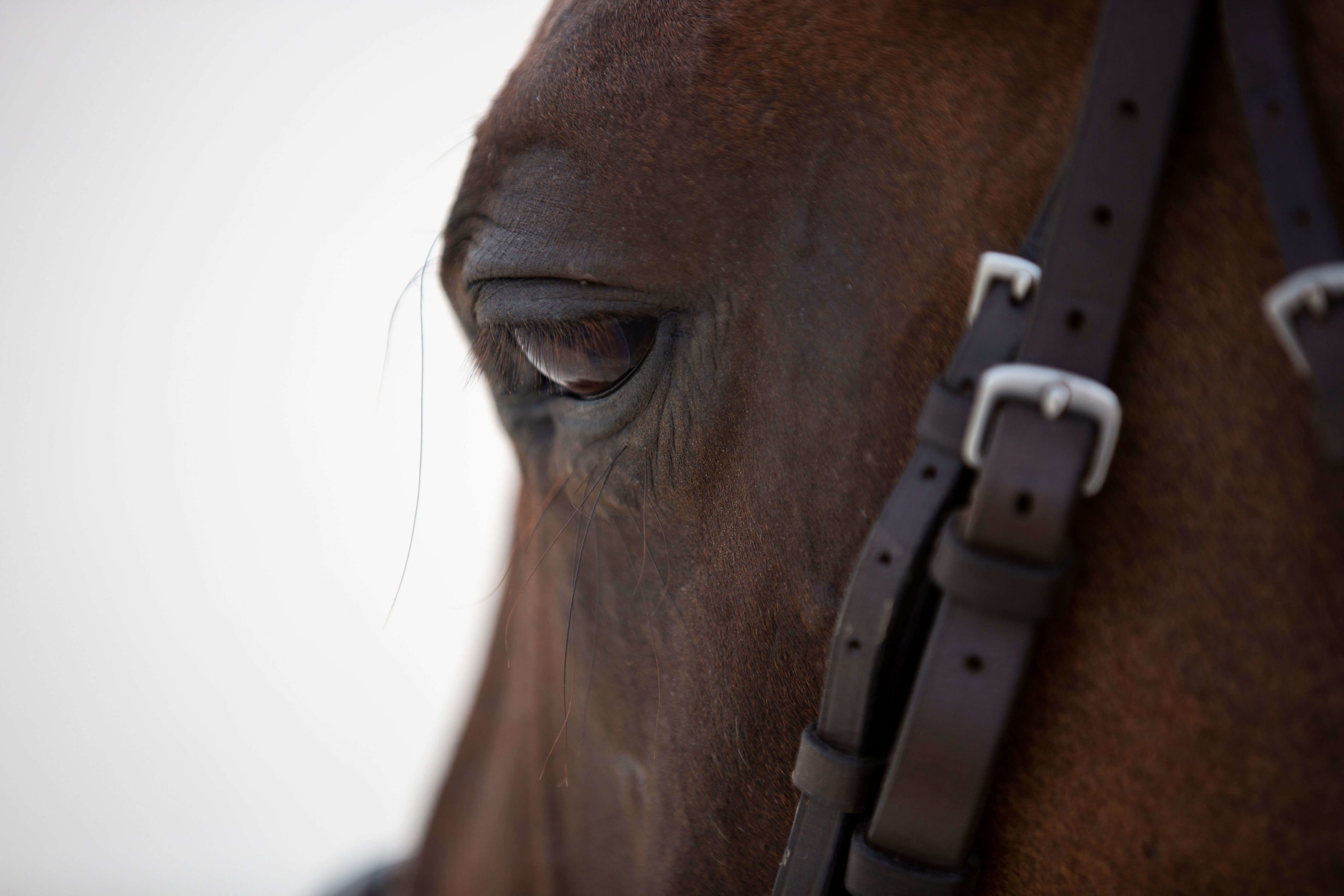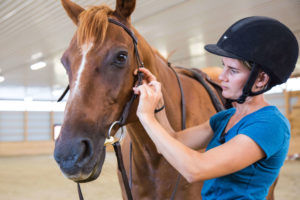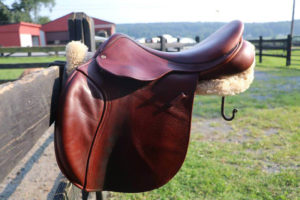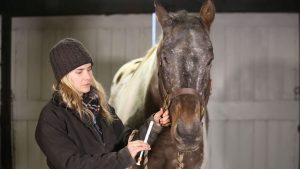It’s an unfortunate part of horse care and ownership, but horses do get sick and injured. When they do, the treatment process can be quite a challenge.
Most medical procedures, whether that is giving a drug orally or through injection, cleaning a wound, or applying a bandage, are inherently an unpleasant experience for the horse. These necessary procedures often involve pain, bitter tasting medications, nasty smelling topicals, or worse.
It can be difficult enough to give oral medications or treat sensitive areas on a small dog or cat, who can be physically restrained. Other livestock species are also medicated with restraints, such as stocks and squeeze shoots for cattle. But with horses, we usually expect them to stand still with just a halter and lead, as we do the necessary procedures.
The vet can sedate the horse for initial treatment, but as owners, we are expected to do the follow up care relying on our horse’s good manners.
With 20-25 horses here on my farm, I’m often treating some kind of injury or issue. This week, one of the horses here, Henry, developed an eye condition and needed ointment in his eye 3x per day.
I decided to video one of his treatments so you can see how I reward good behavior through the obviously not-so-fun procedure for Henry of having his sore eye opened and ointment applied.
You can use the same technique I show here for many other medical procedures.
Hit play to start the video below.














39 Responses
I think any video done on how to care for a horse safely, softly, and in a positive way is just as important as your riding/training videos. This one was great.
I do some of my deworming using natural dewormers. Sometimes that means it’s a liquid that I use a syringe to administer it with. I had one pony that was really a problem. Smart little girl who would stand perfectly still while I rubbed the syringe around her mouth, but knew the second my intent was to give her the the dose. Since it was a 10 day process, by day 3, even catching her was an issue. So, on day 4, once she got her dose, I would immediately drop a treat into her feed bucket. By day 6, she was waiting for me and hasn’t been a problem since, with this, anyway.
Great video! I use a very similar technique when I deworm my horse, Misty, but I’ve always wondered how it would work when it comes to eyes. I really enjoyed watching your video!
A friend who had to treat her horse’s chronic eye condition for an extended length of time gave me a suggestion last summer when I had to treat an eye infection in my horse. She puts the medication on the tip of her gloved finger and then puts the med in the horse’s lower eye lid when it is slightly pulled out. I tried her method and it helped a great deal — as did the rewards for good behavior! It was nice not to have to worry about the pointed tip of the med being in an area that could poke my horse’s eye if he threw his head around.
Thanks Frieda for pointing that out. My vet always warned me not only about the sharp tip of the tube, but also the possibility of contaminating the medication. Use of a gloved finger or a clean washed finger is what he always recommended to me and I’ve never had any issue applying for any of my horses. They are used to my hands and fingers being around their eyes during grooming (including removing nasty eye gunk in the corners of their eyes, so the addition of a small glob of medication was totally transparent to them when necessary
Frieda, that is a great point! We like using the tip of the applicator because it is a little easier to get into the eye than a finger but pulling the bottom part of the eye away is a great suggestion!
Julia Burdy, CRK Training Community Manager
I like the way you used approach and retreat with the ‘cluck’ and reward.
I’d like to offer another technique to apply ointment that my wonderful vet taught me.
Use the same approach/retreat,cluck,reward as you just showed. Apply the amount of ointment (about the size of a pea) to the tip of your index finger. Your thumb and middle finger will be used to spread open the top and bottom eye lid. Be gentle but firm. Dab the ointment into the inner corner of the eye. The ointment will ooze all over the eye as he blinks and you don’t have to worry about touching a very sore eye. As you demonstrated, lots of praise and reward.
My sweet little mare has chronic bilateral uvitis and is on weekly eye ointment. I can approach he in a field and administer the medication without using a halter or cross-tying her.
Practice makes perfect.
Thanks for the vidio
I agree with Frieda as the tip of the tube is not to touch the horse’s eye due to transfer of bacteria onto the tip repeatedly. And always use a clean or sterile light plastic glove. And YES, I really like your approach and retreat with a treat method. Softly done and leaving on a good note. Well done!!
Callie, what you do is unique. Clicker training has been transformative for my OTTB and me. There are so many applications. We’ve had horses occasionally at our barn that have never had feet handled or have other phobias. This technique works.
Hi Callie,
Great video for those times when we need to treat our horses! What are you using as a cookie that is taking that long to eat? My boys seem to get through most treats in microseconds!
We’ve been struggling with needle aversion in one of my boys after a nose-in with a porcupine. I’m going to add the clicker training as a great new option for him in this particular case. I know we have a bit of an uphill battle to overcome the issue, but I think this will be a good tool for my kit!
For sessions like this we actually like to use their feed as the reward and Callie uses a treat pouch to hold them in so she doesn’t run out in the middle of a training session. Good luck with your horse – hopefully he won’t have another porcupine encounter!
Julia Burdy, CRK Training Community Manager
Hi Callie, I’ve seen clicker training being used effectively with dogs, and I’ve heard of it being used with horses too but don’t understand why it works… clicking/snapping sounds for a horse generally spell danger, I thought! (which is why they respond by going faster or moving away from us when we click at them).
Can you explain, please?
Lisa, using the voice is simply a cue and we can connect whatever behavior we choose to a particular cue. In this case, the tongue click is a marker signal for when the horse does the desired behavior (in this case holding his head still for the medication). The marker signal is basically communicating that the horse has found ‘the right answer’. I hope that helps!
Julia Burdy, CRK Training Community Manager
This is excellent. I’m really enoying and learning from your videos!
Love this video on applying eye meds! I had to apply eye meds to my horse and I was not successful. Her head was every where and we even broke a break away halter. My mare stayed at the vets eventually so they made sure the meds got in her eye. If I have to do eye meds again, hope I don’t, I’ll use the clicker and treats! Your method is easier for the horse and handler – thanks!
Perfect timing! I need to administer an injection every 4 days. This positive approach should help! I do it with my dog…. didn’t think to apply same principal to my horse ! I also like the demo of clicking with your tongue vs hand held clicker.
Hi Callie, also here you break the procedure into small steps and you go one step at the time. This will also work for babies and small kids, thank you, ellen
Another terrific video! I have been using clicker training for over a year with my rescue Arabian gelding. I got him when he was 17, and he’d had minimal handling.First I used it to get him to come to me and let me put a halter on him. Now he puts his nose right into the halter! I click and treat him once I buckle his halter and he takes a couple of respectful steps back out of my space.
I also used it to teach him to let me clean his hind hooves. It is really great for many things. Thanks Callie!
Dear Callie,
thank You for the great video!! I have the big problem that so many people are too lazy to try non-violant ways to” comunicate”(in my opinion creating fear is no way of comunicating at all..but anyway) with the horse. The video shows how fast communication can work and that it´s not arduous at all! Did You have Hanry already trained several times on Clickertrainig? Or was ist the first time?
Have a graet day!
Sophia
Henry has done a little clicker training before this video – but not extensively!
Julia Burdy, CRK Training Community Manager
Thank you for video. My horse also has a virus and was hospitalized for 3 weeks. I have had to put a lot of meds in eye and may need to if there is a flare up. I was always told to to give grain after cooperation makes more sense to help horse through procedure with the grain. Thanks.
Love this approach!
Any suggestions for the dentist? I totally expect to have to sedate a horse for dental work, but paying to have her zonkoed every time the dentist needs to even have a routine look is getting expensive – mostly because she then has to be indoors overnight and being indoors means she gets bored and makes trouble. (She’s a real Houdini with bolts and latches…the feedroom has an actual doorknob because nothing else would keep her out!)
We had good success using clicker training for dealing with her feet but I’m not even sure where to start with the dentist, since there doesn’t seem to be any way to break down the steps…and the dentist has now been bitten so many times that he won’t go anywhere near her until she’s so stoned she has to be propped up.
Thank you Callie. Nicely done. I was interested in the fact that “clicker” training is done with a click of the tongue, not an actual clicker. I was wondering how you were going to coordinate a clicker, the head, ointment, and the movement of the horse. Very good information.
Carol, using the tongue click is helpful for this very reason it is less to hold! Callie prefers to use an actual clicker when first introducing clicker training to a horse because it is more consistent but the tongue click is a great trick for working on behaviors as we did in this video.
Julia Burdy, CRK Training Community Manager
Thanks Callie, how about shots? I am so insecure about shots!
May, you can use this same type of sequence for shots! We actually shared a video on this during Training Journals open enrollment on how Callie works with a horse that has an aversion to shots. During that session she uses a syringe without the needle on the end and acts as if she is going to give the vaccine and rewards the horse for moments when he is standing still and relaxing by doing the same click and treat sequence. I hope that helps!
Julia Burdy, CRK Training Community Manager
Nice tips Callie! How would you do it when the horse already has resistance? I have a mare so difficult to be injected, and I would like to work on it to prevent future problems to give her some medication if she needs it. I’ll try to split the re-education into some sessions, but how long each session may be? Thanks!
Nice video Callie!
I have a mare so problematic to be injected, and I would like to try re-educate her on this way to prevent problems if she has to be injected. I will have to do it in some sessions I think. What’s the ideal duration of each session in your opinion?
Thanks!
Pedro, I would definitely recommend multiple sessions and the ideal duration of the session can vary from horse to horse depending on their level of engagement. Last year around this time we had a horse in training named Zelli who had an extreme aversion to oral medications and her sessions were spread over 4 to 5 weeks, about 5 times a week, sessions lasting about 15 minutes. I hope that is helpful!
Julia Burdy, CRK Training Community Manager
Thanks so much Julia! This is a good start, I’ll play with session time to fit to my mare starting on this advice
Plz send that vedio of ur some ointments of whitening
Ayeman, what video are you referring to? I’d be happy to send it if you can give me more specifics on what it was!
Julia Burdy, CRK Training Community Manager
Hi Callie! I have used the clicker training using a hand held clicker. It works great, but you almost need three hands to really do something to your horse. I love your idea of using your tongue as a clicker. It would be easier to translate to riding, too.
Exactly, Cathy. The tongue click is great to use when you don’t have a free hand or like you said for in the saddle!
-Julia Burdy, CRK Training Community Manager
Almost looking forward to trying this today. Red mare has conjunctivitis and I had a hard time last night.
Oh I hope this helps Melissa!
-Julia Burdy, CRK Training Community Manager
So I tried this! First time. Great. Not the rest. He yanks that head up and pulls away and I’m fighting to get the drops or cream in. I come in from top to hide the little bottle of drops. I’ve discouraged with bucket of feed. Works a tad better. I want this to work properly. But I may have to twitch. Help. How do you do this with a head pulling away horse??? Thank you
Angela, do you have a friend that can help you?
-Julia Burdy, CRK Training Community Manager